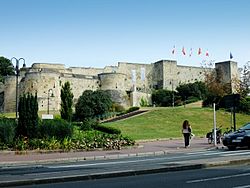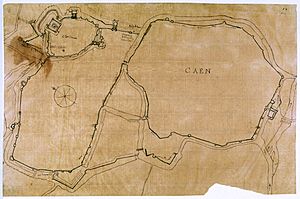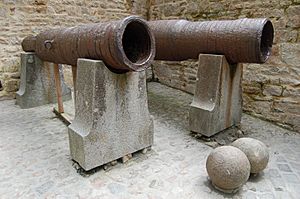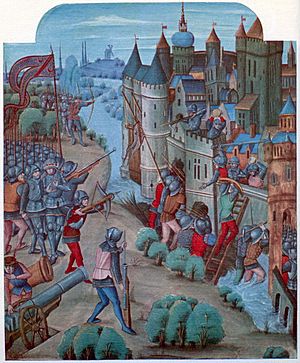Siege of Caen (1417) facts for kids
Quick facts for kids Siege of Caen |
|||||||
|---|---|---|---|---|---|---|---|
| Part of the Hundred Years' War | |||||||
 The Chateau de Caen |
|||||||
|
|||||||
| Belligerents | |||||||
| Commanders and leaders | |||||||
The siege of Caen happened during the Hundred Years' War. English forces, led by King Henry V, attacked and captured the city of Caen in Normandy. The French defenders of Caen eventually surrendered to the English.
Contents
Why the Siege Happened
After his big win at the Battle of Agincourt in 1415, King Henry V went back to England. That battle showed the French would not fight the English in a large open battle again. But it did not help Henry become king of France. So, he decided to gather an even bigger army.
Preparing for Battle
In March 1417, Henry started getting his army ready in Southampton. He put together about 12,000 soldiers and archers. He also had around 30,000 support staff. These included gunners, engineers, miners, and armor makers. They brought a huge amount of supplies. This included all kinds of siege engines, cannons, and gunpowder. On July 23, the entire force began to get on about 1,500 ships. They finally sailed for France on July 30.
The Siege of Caen Begins
The English army landed in Normandy near Deauville. King Henry's plan was to capture the main cities and towns in Lower Normandy. Then, he wanted to move towards Paris. His first target was Caen. It was the second largest city in Normandy. About 40,000 people lived there.
Caen's Defenses
Caen had strong defensive walls that had been recently improved. These walls had twelve gatehouses and thirty-two towers. The older part of the city, called the upper town, had a castle. This was the Chateau de Caen. It sat on a hill looking over the lower, newer part of the city. The lower town was almost completely surrounded by a bend in the River Orne.
The French soldiers in Caen started tearing down buildings outside the walls. They did this so the English attackers would not have places to hide. However, two large monasteries were still standing when the English arrived. The English advance group, led by Thomas of Lancaster, Duke of Clarence, quickly took over the Abbey of Sainte-Trinité as their base.
A story says that a monk from the other monastery, the Abbey of Saint-Étienne, asked Clarence not to let the French destroy his church. The monk offered to show the English a way over the abbey walls. The English captured this abbey. It had a great view over the town. King Henry later put cannons on its roof.
Attacking the Walls
Henry built a bridge over the river. On August 18, he began the attack on the lower town with a heavy cannon bombardment. The English cannons were so large that their firing broke the abbey windows. The bigger cannons shot solid stone balls. Some fired hollow iron shells filled with burning material. Smaller guns shot many lead pellets.
Henry also tried to dig tunnels under the walls to make them fall. This was called undermining. But the French defenders put bowls of water on the walls. By watching the ripples in the water, they could tell where the English were digging. Then, they would dig their own tunnels to fight the attackers underground.
The Final Assault
The French commander, Guillaume de Montenay, refused to surrender. So, Henry planned a full attack for September 4. The attack on the lower town came from two sides. King Henry led one group, and the Duke of Clarence led the other.
The English crossed the moat by filling it with fascines (bundles of wood). Their scaling ladders were too short at first. It was very hard to get over the wall. The defenders fought back hard. They threw quicklime, rocks, and boiling water down on the English. During the siege, an English knight, Sir Edward Sprenghose, managed to climb the walls. But he fell and was burned alive by the defenders, who threw burning straw on him.
Clarence's soldiers broke through first. A soldier named Harry Ingles was the first over the wall. There was fierce fighting from house to house. Richard Beauchamp, 13th Earl of Warwick shouted "A Clarence, a Clarence, a St George!" His men cleared the defenders from the walls. They then opened the gates for the king's men to enter.
After the City Fell
The rules of war at that time meant that if a city's soldiers refused to surrender, they were at the mercy of the attackers. English writers praised Henry because he ordered that no women or priests should be hurt. He also said churches should not be robbed. However, his soldiers forced everyone they could find into the market square. There, they killed between 1,800 and 2,000 people. One story says Henry stopped the killing when he saw a woman's body without a head, with a baby in her lap. After that, the English soldiers were allowed to take whatever they wanted from the town.
The castle had about a thousand people who had fled there from the fighting. It surrendered on September 20 without being attacked or bombed. De Montenay gave the keys to Henry. Henry was fair to the defenders. The soldiers could leave with their horses, weapons, and equipment. They could also take up to 2,000 écus (a type of coin) each. Civilians could leave with only the clothes they were wearing. Or, they could stay and promise to be loyal to Henry. About 700 citizens left the city. De Montenay and his soldiers went to join the defenders of Falaise.
What Happened Next
While the siege was still happening, Clarence wrote to the Lord Mayor of London. He said that English settlers would be needed to live in Caen. When they arrived later, they were given empty houses. In the months that followed, Henry went on to capture Argentan, Falaise, and Cherbourg.
Then, he moved east and attacked Rouen. Rouen was considered France's second most important city. The difficult Siege of Rouen lasted from July 1418 to January 1419. Capturing Rouen gave Henry control of all of Normandy. This became a strong base for him to push towards Paris. Henry finally died in 1422 during the Siege of Meaux.
Caen stayed under English control until 1450. In that year, it was attacked and taken back by the French. This happened during the French effort to win back Normandy in the final parts of the war.




